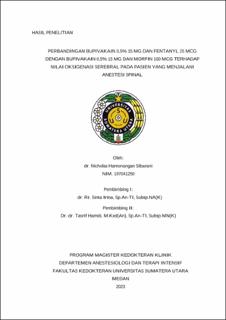Perbandingan Bupivakain 0,5% 15 Mg dan Fentanyl 25 Mcg dengan Bupivakain 0,5% 15 Mg dan Morfin 100 Mcg terhadap Nilai Oksigenasi Serebral pada Pasien yang Menjalani Anestesi Spinal

Date
2023Author
Sibarani, Nicholas Hamonangan
Advisor(s)
Irina, Rr. Sinta
Hamdi, Tasrif
Metadata
Show full item recordAbstract
Background: Spinal anesthesia is an anesthetic technique used for elective and emergency surgery. Cerebral blood flow is defined as the difference between mean arterial and intracranial pressure, and is inversely proportional to cerebrovascular resistance. Non-invasive methods of monitoring tissue oxygenation can provide useful information about tissue oxygenation and microcirculation conditions. One technique for monitoring tissue oxygenation is near-infrared spectroscopy (NIRS). Previous studies have shown that spinal anesthesia adversely affects cerebral oxygenation, especially in the administration of fentanyl in addition to spinal anesthesia. Nonetheless, offering fentanyl as adjuvants has many clinical benefits.
Objective: Obtain a comparison of cerebral oxygenation of Bupivacaine 0,5% 15 mg plus Fentanyl 25 mcg to Bupivacaine 0,5%15 mg plus Morphine 100 mcg in patient with spinal anesthesia
Methods: This research is using randomized control trial. The aim is to compare the value of cerebral oxygenation. Total sample is 36 patients. Samples are divided into 2 groups, the group that received Bupivacaine 0,5% 15 mg plus Fentanyl 25 mcg and Bupivacaine 0,5%15 mg plus Morphine 100 mcg. rSO2 was assessed before spinal (T0), 5 minutes after spinal (T1), and 30 minutes after spinal anesthesia (T2).
Results: The average of rSO2 in patients with Bupivacaine plus Fentanyl was 68-72 on both sides. The average of rSO2 in patients with bupivacaine plus Morphine was 69-70 on both sides. There was a significant difference of rSO2 at T1 and T2 in patients receiving Bupivacaine 0,5% 15 mg plus Fentanyl 25 mcg and Bupivacaine 0,5%15 mg plus Morphine 100 mcg.
Conclusion: The rSO2 in this study is decreased insignificantly in Fentanyl’s group at T0 and T1 on both sides. Meanwhile at T2 decreased significantly. In Morphine’s group, there was a insignificant decrease at T0 and T1 on both sides. Meanwhile at T2 decreased significantly.
This was due to the onset of Fentanyl and Morphine at 15 minutes as of rsO2 decrease significantly at T2. Both groups gave the same impact to the change of rsO2
